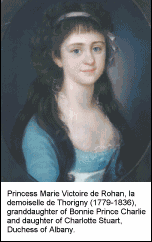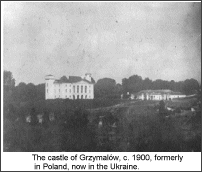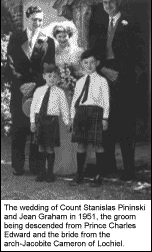History discloses her secrets in curious ways –
sometimes centuries if not millennia after the event. Meanwhile myths,
legends or, at best, reasoned theories fill the voids. There are few
better examples of this than in the chequered lives of the later members
of the Royal House of Stuart. But now, the chance linking of clues and
discovery of some extraordinary circumstantial evidence held in the
archives of seven European countries has resulted in a fundamental review
of long-accepted conclusions about the presumed extinction of this most
colourful and tragic royal family.
This is a story of love, passion, intrigue and
tremendous family loyalty, meticulously traced back over many generations
by Count Peter Pininski, an independent historian in Warsaw. It is also his
story and it has led him from Scotland across the European continent
in his exploration of historic events and the relationships between
members of the Scottish, French and Polish nobility, culminating in a
ground-breaking historical conclusion.
The end of the Stuart line?
More than two centuries have passed since the death in
Rome in 1788 of Prince Charles Edward Stuart, the "Young
Pretender" and last serious Stuart claimant to the British throne.
Until the 1950s it had been believed that the royal Stuart line had died
out in 1807 with the death of Charles' brother, Henry, Cardinal Duke of
York – "Henry IX" to Jacobites. Then research work by the
distinguished historians A & H Taylor and, later, the discovery of
certain letters by Professor George Sherburn led to claims of another
generation of Stuarts. Prince Charles Edward's daughter, Charlotte, by his
mistress Clementina Walkinshaw had, it seemed, given birth to three
children, a son and two daughters. The daughters were rumoured to have
died young and childless in the 1820s. The son, Charles, died in 1854
without issue, and it was assumed that this finally marked the end of the
royal Stuart line.
Now, new evidence unearthed by Peter Pininski, and
described in his forthcoming book The Stuarts' Last Secret, indicates
that, while one of Charlotte's daughters did indeed die childless, the
other, Marie Victoire, married a prominent Polish nobleman, bearing him a
son whose descendants survive to this day.
 So
why have historians for so long failed to recognise that the Young
Pretender's daughter Charlotte did have children? This seeming mystery can
be explained by the strict secrecy necessary to conceal details of the
illicit relationship between Charlotte Stuart and Prince Ferdinand
Maximilien Mériadec de Rohan-Guéméné, Archbishop of Cambrai, the
father of her children.
So
why have historians for so long failed to recognise that the Young
Pretender's daughter Charlotte did have children? This seeming mystery can
be explained by the strict secrecy necessary to conceal details of the
illicit relationship between Charlotte Stuart and Prince Ferdinand
Maximilien Mériadec de Rohan-Guéméné, Archbishop of Cambrai, the
father of her children.
"In 1775," notes Peter Pininski,
"Charlotte was forbidden by her father either to take the veil or to
seek a partner in marriage. The reason for this was that Prince Charles
Edward harboured the hope that, through some eventual 'political' marriage
of his design, his daughter might eventually become a means of rescuing
the Stuart cause. This left Charlotte in an invidious position. She was a
Stuart, yet unrecognised by her father (Charlotte was only formally
recognised as her father's heir in 1783, when she became HRH Duchess of
Albany). She was in the prime of her life, yet had no dowry – and
certainly could not form a relationship with just 'anyone'… The de
Rohans were anything but, being recognised internationally as 'sovereign
princes by the grace of God', being descendants of the ancient Celtic
kings of Brittany and related not only to the Stuarts, but also to the
Houses of Bourbon and Lorraine."
But of course, Prince Ferdinand's career in the church
– into which he had been forced as the youngest of four sons –
naturally forbade any such relationship. Meanwhile, discovery by
Charlotte's father or her uncle, Cardinal Henry, of her secret family,
would have jeopardised her potential status as Stuart heiress – and
presented the Hanoverians with an unprecedented opportunity to drive the
final nail into the coffin of Jacobitism. The consequent secrecy
surrounding her liaison and her children meant their lives were to remain
shrouded in mystery for almost two hundred years.
Known facts – and new evidence
Brought up in England, his father Polish, his mother
Scottish, Peter Pininski has long been interested in his family
background. He knew that his father was a descendant of the Pininskis, a
noble family granted the hereditary title of Count in 1778 by Empress
Maria Theresa of Austria in the first stage of the partitioning of Poland
between Russia, Prussia and Austria. Peter's mother was a descendant of
the influential Scottish Cameron of Lochiel clan. Strongly loyal to the
Jacobite cause, this highland clan had been leading supporters of Charles
Edward in the disastrous 1745 uprising against the English.
Against this family background and following the death
of his paternal grandmother in 1976, Peter Pininski threw himself into
researching his Polish family history. Over the next few years he read
avidly, learned Polish, corresponded with relatives far and wide and, in
the first year of the free trade union "Solidarity" embarked on
a year's research work at the National Museum in Warsaw – a project cut
short when the democratic opposition was crushed. Following the fall of
communism, he resolved to start a new life – in Warsaw. It was then that
the pieces of his family jigsaw began to fall into place.
"In my family," recalls Peter, "we had
always known that my four times great grandmother was the natural daughter
of a Prince de Rohan. And that until Gryzmalów, our castle in
south-eastern Poland, was devastated by the Russians during the First
World War, there had been letters, apparently from her father, kept in an
antique desk together with the family's oldest and most valuable
documents, some dating back to the fourteenth century. Even today a pastel
portrait of her as a young, smiling woman with bright blue eyes hangs at
the home of my aunt in southern Poland. I have another in my apartment in
Warsaw. But no-one in the family had ever tried to find out who she really
was."
 The
first clue to her identity emerged in the summer of 1997 when Peter read a
biography of Bonnie Prince Charlie in which it was mentioned that the
Prince's only child, Charlotte, had borne three natural children by Prince
Ferdinand de Rohan. Given what Peter knew about his Polish family
background, mention of a Prince de Rohan intrigued him.
The
first clue to her identity emerged in the summer of 1997 when Peter read a
biography of Bonnie Prince Charlie in which it was mentioned that the
Prince's only child, Charlotte, had borne three natural children by Prince
Ferdinand de Rohan. Given what Peter knew about his Polish family
background, mention of a Prince de Rohan intrigued him.
Peter visited archive collections throughout Europe in
pursuit of all possible documentation – birth, marriage and death
certificates, books, journals, diaries, letters…. His search was not
without its frustrations. The upheavals of European history meant many
documents had gone missing. Historical misreporting often led to
complications. In addition, aliases had routinely been used to protect the
identities of Marie Victoire, her parents and siblings: de Rohan and
Stuart had become Roehenstart; Ferdinand was recorded as Maximilien;
Charlotte was Clementina Ruthven, while Charles became Auguste Maximilien.
Nevertheless, meticulous matching of times, places and events meant Peter
was able to piece together the evidence.
It was at this time that he was contacted by a
professional genealogical researcher and member of the Burke's Landed
Gentry editorial team, Roger Powell who, by pure coincidence, was just
about to embark on his own research into the life of Prince Charles Edward
Stuart's grandson, Charles "Roehenstart". A successful
collaboration resulted in the discovery in the Public Record Office,
London of the certificate of Marie Victoire's second marriage and her
second husband's will. These gave Peter further leads. His painstaking
research also uncovered substantial evidence indicating that the portrait
on his Warsaw wall was of none other than Marie Victoire, one of the two
granddaughters of Prince Charles Edward.
The final chapter
"Fortunately for Charlotte and her children,"
explains Peter, "the de Rohan family was renowned for its family
solidarity. Ferdinand's brother, Jules-Hercule, Prince de Guéméné and
Duke of Montbazon (who had been an aide de camp to Henry Stuart during the
Jacobite uprising of 1745), undertook to claim his brother's children as
his own.
"Marie Victoire was baptised in 1779 in the chapel
of his estate in Couzières and Jules-Hercule conferred on her the title
of 'demoiselle de Thorigny'. No head of the de Rohan family and no Duke of
Montbazon had ever recognized an illegitimate female child before."
Ten years later Charlotte died, just one year after the
death of her father. That same year the French Revolution broke out,
causing various members of the family to seek refuge in countries such as
Germany and Switzerland. Marie Victoire eventually went to Poland where,
through the Stuarts' closest Polish cousins, the Princes Radziwill, she
met and then married Paul de Nikorowicz, an hereditary chevalier of the
Holy roman Empire and son of a leading banker who was the Radziwill's
trusted financier and adviser. Marie Victoire and Paul had a son, Antime,
but, just four years later, Marie Victoire was left a widow. She returned
to Paris with her young son and there, thirteen years later, she married a
certain Corbet James d'Auvergne, a British naval captain from an old
Channel Islands family. "D'Auvergne," explains Peter,
"wished to exploit Marie Victoire's relationship with the de Rohan
princes, against whom his family had recently lost a court battle to
establish the rights of succession to the Duchy of Bouillon. However, he
died fourteen months later. Meanwhile Antime inherited a large fortune in
landed property near Lwów and the sixteenth century Castle of Grzymalów."
Marie Victoire returned to Lwów where she married Jean
de Pauw, an old French friend and retired army officer. In 1830, through
Antime, she became a grandmother for the first time. Her grandson was
christened Charles – the first time this name had ever been used in the
Nikorowicz family. A sister for Charles soon followed. Called Julia-Thérèse,
she was eventually to marry Count Leonard Francis Xavier Pininski, a
member of a family with a quite extraordinary history of its own… but
that is another story.
Peter relates that "Leonard and Julia in their turn
had four boys, only the youngest of which, Alexander August, left male
heirs, Ladislas and Mieczyslas. Mieczyslas married a young ballerina with
the Lwów Opera and inherited the family estates including the greater
part of Grzymalów. He was my grandfather.
"Following Polish independence in 1918, Lwów,
which had been the thriving, cosmopolitan capital of the Austro-Hungarian
empire's largest province, became a provincial Polish city. Perhaps
seeking a more exciting environment, Mieczyslas established his family
base in Paris, commuting to Lwów when necessary to oversee his properties
and businesses there. It was in Paris in 1925 that his son, Stanislas, or
"Stash", my father, was born. It was intended that Stash should
be educated in Paris and then trained in modern agricultural methods, with
a view to his returning to Poland to take over the family estates."
The Second World War was to upset these carefully laid plans.
Peter describes how, "In 1939 as the clouds of war
gathered, my grandfather sent my grandmother and father to holiday with
close friends in England, while he went to take care of his properties in
Poland – his timing could not have been worse. He eventually managed to
flee to the Istrian peninsula where he owned a villa. Sadly, although he
survived the war, he died there in early 1945 – killed, we believe, by
Tito's partisans.
"My father Stash, meanwhile, had remained with his
mother in England where he flew with the Polish airforce. They suffered
considerable financial hardship which was not alleviated at the end of the
war. All the family's properties and possessions were lost when the 'Iron
Curtain' descended between East and West, and a sale of the contents of
the Paris flat fetched only a fraction of their true value. Despite their
difficult financial situation, my grandmother insisted that my father
complete his education so he studied economics at St. Andrew's. There he
fell in love with a fellow student, Jean Graham, whom he married in 1951.
She was to be my mother.
"So, through a series of coincidences spanning some
250 years of turbulent European history, our family history had come full
circle, leading us back to Scotland, the native land of Stuart and Cameron
ancestors on either side of my family who, long ago, had been united in
the Jacobite cause.
"Even earlier Scottish-Polish links were
established through Prince Charles Edward's ancestry – he was not only
heir to Scotland's royal dynasty, but also the son of Princess Clementina
Sobieska, grand-daughter of King John III of Poland, famed for his heroism
in saving Europe from the Turks at the Battle of Vienna in 1683…"
 In
history, as in any other field, absence of evidence is only too frequently
equated with evidence of absence. In the case of the royal Stuart line,
the absence of any records tracing the adult lives of Charlotte's
daughters led to the belief that they had both died childless. "Until
recently," notes Peter, "there seemed no reason to question this
conclusion. Marie Victoire's over-riding family loyalty had ensured her
secret went with her to the grave while her Polish descendants had no
reason to suspect her royal lineage." Now, however, her history and
that of her descendants has at last been written.
In
history, as in any other field, absence of evidence is only too frequently
equated with evidence of absence. In the case of the royal Stuart line,
the absence of any records tracing the adult lives of Charlotte's
daughters led to the belief that they had both died childless. "Until
recently," notes Peter, "there seemed no reason to question this
conclusion. Marie Victoire's over-riding family loyalty had ensured her
secret went with her to the grave while her Polish descendants had no
reason to suspect her royal lineage." Now, however, her history and
that of her descendants has at last been written.
Peter Pininski's book, The Stuarts' Last Secret, is
to be published in October 2001 by Tuckwell Press.
Our thanks to Burkes
Landed Gentry for this story

